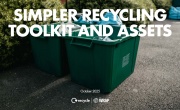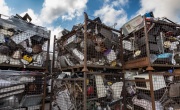An eye on the markets: Bringing fibre home
Peter Seggie, External Affairs Manager at Smurfit Kappa Recycling UK, sees a positive outlook for the European fibre recycling industry
There has been much media attention of late on the ‘crisis’ in the fibre recycling industry following strict quality controls introduced by the Chinese Government on imports of waste-based materials, including paper for recycling (PfR). However, these reports must be considered in the context of Europe’s hugely successful fibre recycling performance at home, where the vast majority of used paper products collected are recycled back into new products within Europe. In 2016, 60 million tonnes of used paper were collected in Europe, with 50 million tonnes recycled in European paper mills and the remainder exported to global markets to support the sustainability of their paper making industries (returning the paper packaging from goods coming into Europe from Far Eastern manufacturing).
 Over the last 20 years, European paper mills have invested heavily to increase their use of PfR as a raw material, giving Europe a recycling rate of over 70 per cent (the amount of paper collected for recycling against the amount of paper products consumed). This increasing demand for PfR has supported huge growth in collections, particularly from European households. Further large scale investments are planned over the coming years (particularly in the paper packaging sector to support e-commerce growth) and this will increase demand further for European PfR into the future.
Over the last 20 years, European paper mills have invested heavily to increase their use of PfR as a raw material, giving Europe a recycling rate of over 70 per cent (the amount of paper collected for recycling against the amount of paper products consumed). This increasing demand for PfR has supported huge growth in collections, particularly from European households. Further large scale investments are planned over the coming years (particularly in the paper packaging sector to support e-commerce growth) and this will increase demand further for European PfR into the future.
China, as a market for PfR collected in Europe, is a marginal player (albeit an important one) and as such the threat from its new import restrictions are limited to a relatively small amount of material. There is still massive demand in China for imported PfR to feed huge paper mills that support its export based economy and Chinese buyers continue to source high quality material globally. However, they will no longer tolerate the marginal qualities that previously entered their markets on a relatively simple basis, leading to the phrase ‘foreign garbage’ being used in China’s submission to the World Trade Organization (WTO).
 This article was taken from Issue 92
This article was taken from Issue 92The issue for the UK is that in our rush to develop used paper and cardboard collection systems to meet weight based recycling targets (particularly from households) we introduced immature collection systems compared to other major EU Member States. They have collected used fibre for much longer and developed systems to meet the quality standards of the European paper recycling industries, while we opted for systems designed around Chinese and Far Eastern markets. In 2016, the UK relied on the Chinese market to take 47 per cent of its PfR collections, compared to just 13 per cent exported to Europe. This situation remained acceptable as long as Chinese and other Far East markets stayed open and pulled the UK excess to feed their ravenous machines, with little thought for overall quality.
Clearly this situation has now changed with the new Chinese import restrictions; quality has become the key driver as China seeks to limit environmental impacts from its heavy industries. No longer is the government happy to tolerate the rejects from Chinese mills associated with non-paper scrap that has travelled vast distances alongside the valuable paper fibres. China only wants the paper fibres now and has achieved this by banning mixed papers (associated mostly with household collections) and limiting the levels of contamination allowed in other PfR grades – such as used packaging – to well below that demanded by European mills.
So China is now driving global PfR quality, and things need to change. The upside is that if collectors achieve the new Chinese quality criteria then they can sell their PfR anywhere in the world, as the material will be globally competitive and very attractive to all markets. The downside is that this is likely to require a switch to segregation of used fibre at source, at a time when local authority budgets are tight and the value of low quality PfR has fallen through the floor.







